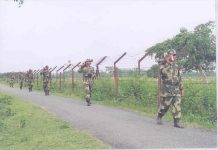
For months together at the Tate Modern in London, one big room at the Project Space Gallery housed a multitude of sounds and voices, at once a harmony and a cacophony that enveloped any listener. This overlap of voices, of the spoken word and of song, formed the Tate Modern’s international art exhibition Word. Sound. Power. A collaboration with Khoj International Artists’ Association in New Delhi, the exhibition now travels to the city, to open at Khoj’s studios on 15 January. Though the core of the show – eight artists exploring voice, sound, poetry and the politics inherent in them – remains the same, in the hands of Khoj’s curator Andi-Asmita Rangari, a change in space will lend a new energy, a new dynamic and a new conversation.
“Why not explore the poetry in resistance,” asks Pooja Sood, director of Khoj, immediately picking on that one thread that brings the show together. She brings up Sufi poetry as an example of art as a form of resistance and subversion. Through the medium of film, of performance, of languages, the artists here explore poetry and how it gives a voice to all those on the margins of society.
A significant part of the show is about films becoming works of art. For Sood, it is an attempt to move away “from documentary to the installation” as she talks about video artist and filmmaker Amar Kanwar’s work A Night of Prophecy. The 2002 film, one of Kanwar’s masterpieces, travels across several conflict zones in India — Maharashtra, Andhra Pradesh, Kashmir, Nagaland — to talk about violence, bloodshed and the fervour of change through music and poetry. A work such as this one shares gallery space with Anjali Monteiro and KP Jayasankar’s 2001 film, Saacha (The Loom), that features the poet Narayan Surve and the painter Sudhir Patwardhan, and uses their art to reflect on issues related to labour and industry in Mumbai’s textile industries.
Well known works aside, Sood’s words are echoed by Pallavi Paul, a young artist whose first two independent films Nayi Kheti and Shabdkosh got a dream debut at the Tate Modern. Paul’s non-fiction lends itself to an exploration of something that borders on fantasy. It is not just documentary, or documentation, as non-fiction is generally thought to be. In her words, “I put the non-fiction through the pressures of fantasy, through that terrain, to check its resilience.”
Her two films, which she has made to flow organically into one another, also feature the figure of the poet, in many forms. The dead poet Federico Garcia Lorca, the man who remembered him, Jack Spicer, and Vidrohi, a poet Paul interacted with at Delhi’s Jawaharlal Nehru University. All three have real and imagined conversations with each other, about poetry, about cinema, about everything. There is the anxiety of being remembered, of leaving behind an archive, an anxiety that surely must strike any artist. This is the conceit that makes for memorable pieces of art.
What one leaves behind depends heavily on language, and how that language is understood. In Mithu Sen’s work, the question of being marginalised by the English language is raised and she claims her space through I Am a Poet — her performance of reading out asemic writing. An established poet in Bangla, Sen has a deep engagement with the anxiety of language, of one’s art possibly being unacknowledged due to the language the audience speaks and understands. An issue that has been raised before by other contemporary Indian artists — most notably Paribartana Mohanty — who battle the dominance of English in the urban art world.
In mediums such as film and sound, the notion of space is important. With all senses being called upon by the work in hand, the curation can make or break a show. What happens at the Khoj’s studios remains to be seen, but the works do seem to be coming together strongly in an attempt to examine the politics of dissent, of poetry, and the long history the two share.













